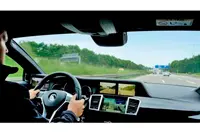 Continental has used a prototype vehicle to demonstrate how a camera monitor system can replace a car's exterior and interior mirrors. Instead of the rear-view mirror, the driver has two monitors with organic light emitting diodes (OLEDs) oriented in the usual viewing directions and displaying what is happening at the rear and sides of the vehicle.
Continental has used a prototype vehicle to demonstrate how a camera monitor system can replace a car's exterior and interior mirrors. Instead of the rear-view mirror, the driver has two monitors with organic light emitting diodes (OLEDs) oriented in the usual viewing directions and displaying what is happening at the rear and sides of the vehicle.
In addition to giving the driver a wider field of vision, the system is said to eliminate glare, provide traffic situation detection with driver assistance functions, is much less susceptible to dirt and dust, makes damaged wing mirrors a thing of the past and gives drivers better vision in poor light and rain.
If the approval of these camera-monitor systems goes through as planned in 2016, the systems could already be in use in vehicles starting in 2018.
"There are no blind spots in this camera monitor system. The effects of unwanted optical phenomena such as glare and weak light can also be compensated," said Alfred Eckert, director of the Advanced Engineering department in Continental's Chassis & Safety Division. "By eliminating the wing mirrors, we have created an additional benefit, because the vehicle's air resistance is reduced. The lower air resistance reduces fuel consumption and wind flow noise at higher speeds is diminished."
To provide the best possible display of the lighting conditions on the monitors, the cameras are equipped with a High Dynamic Range (HDR) function that reduces bright sunlight, for example, to a white surface without flare. HDR is also said to improve visibility at dusk.
The image processing system uses the images created by the three cameras to stitch together a corresponding image for each monitor. In addition to the usual mirror images, the driver's field of vision is also expanded by areas the driver could not normally see. For instance, they can use different picture modes to get a view of the side and the rear of the vehicle. Combined with suitable orientation, Continental claims this image stitching prevents any gap in the field of view, especially the accident-prone blind spots of conventional mirrors.
In a holistic HMI, where the existing hardware and software can be dynamically adapted to the driver's needs by networking, digital mirrors expand the possibilities of assisting the driver. They can increase the 'situational awareness' of events in the traffic environment, for instance.
Initial field trials and an in-house study by Continental have shown that digital mirrors are preferred to conventional models. Human testers found that these images were easy to perceive and that the entire system was attractive to use.
Author
Tom Austin-Morgan
Source: www.newelectronics.co.uk

